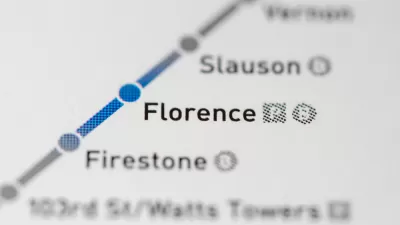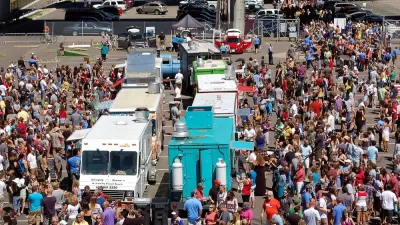A new paper in the Regional Science and Urban Economics journal presents a lukewarm review of the Minneapolis Blue Line’s impact on development through 2010—doing little to buoy the market during the Great Recession.
Adam Belz reports on a new paper by Sarah West and Needham Hurst that will be published in Regional Science and Urban Economics finding that the Blue Line created “almost no increase in the likelihood of new development up to 2010” for the lights rail line that has connected Downtown Minneapolis and the Mall of America since 2004.
To sum the paper’s lackluster review of the development impact of the line: “They found ‘no effect’ along the corridor compared with the 1997-2000 period before construction started on the rail line, and found that parcels within a half-mile of rail platforms were only 1.39 percent more likely than parcels citywide to be developed after the line started operating, compared with the years the rail line was under construction.” For the record, the new report’s findings contradict the narrative about the rail line’s impacts from 2006.
“The paper also finds that light rail failed to insulate the corridor from the effects of the Great Recession,” writes Belz. A quote from West furthers that point: “If the light rail has a catalyst effect, we would still expect for there to be relatively less of a hit taken within the corridor, and we don’t find that…”
In the period following the paper’s purview, anecdotal evidence seems to suggest that the corridor’s stagnancy is improving. “West and Hurst are careful to point out that their paper does not address development since 2010 — ‘casual observation of activity along the line in 2012 and 2013 suggests that substantial changes are taking place now that market outlooks have improved,’ they wrote — and that the effects of light rail can take a long time to manifest themselves.”
Belz cites the study as a cautionary tale ahead of the soon-to-be-completed Green Line, which will shuttle riders between Downtown Minneapolis and St. Paul.
FULL STORY: Study says Blue Line's development impact is minimal

Manufactured Crisis: Losing the Nation’s Largest Source of Unsubsidized Affordable Housing
Manufactured housing communities have long been an affordable housing option for millions of people living in the U.S., but that affordability is disappearing rapidly. How did we get here?

Americans May Be Stuck — But Why?
Americans are moving a lot less than they once did, and that is a problem. While Yoni Applebaum, in his highly-publicized article Stuck, gets the reasons badly wrong, it's still important to ask: why are we moving so much less than before?

Using Old Oil and Gas Wells for Green Energy Storage
Penn State researchers have found that repurposing abandoned oil and gas wells for geothermal-assisted compressed-air energy storage can boost efficiency, reduce environmental risks, and support clean energy and job transitions.

Updating LA’s Tree Rules Could Bring More Shade to Underserved Neighborhoods
A new USC study finds that relaxing Los Angeles’ outdated tree planting guidelines could significantly expand urban tree canopy and reduce shade disparities in lower-income neighborhoods, though infrastructure investments are also needed.

California's Canal Solar Projects Aim to Conserve Resources and Expand Clean Energy
California’s Project Nexus has begun generating electricity from solar panels installed over irrigation canals, with researchers and state agencies exploring statewide expansion to conserve water and boost clean energy production.

HHS Staff Cuts Gut Energy Assistance Program
The full staff of a federal program that distributes heating and cooling assistance for low-income families was laid off, jeopardizing the program’s operations.
Urban Design for Planners 1: Software Tools
This six-course series explores essential urban design concepts using open source software and equips planners with the tools they need to participate fully in the urban design process.
Planning for Universal Design
Learn the tools for implementing Universal Design in planning regulations.
Heyer Gruel & Associates PA
City of Moreno Valley
Institute for Housing and Urban Development Studies (IHS)
City of Grandview
Harvard GSD Executive Education
Salt Lake City
NYU Wagner Graduate School of Public Service
City of Cambridge, Maryland





























